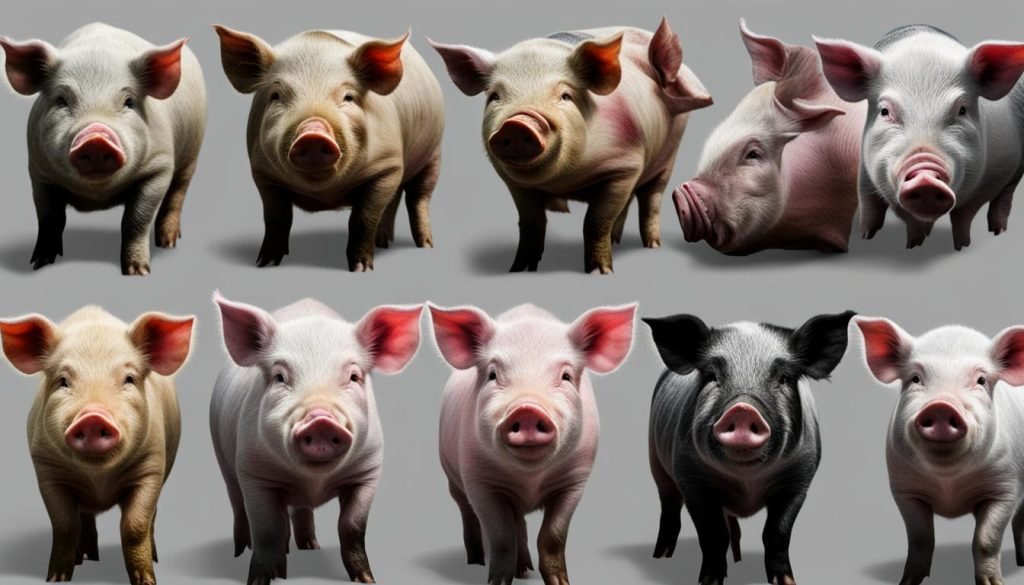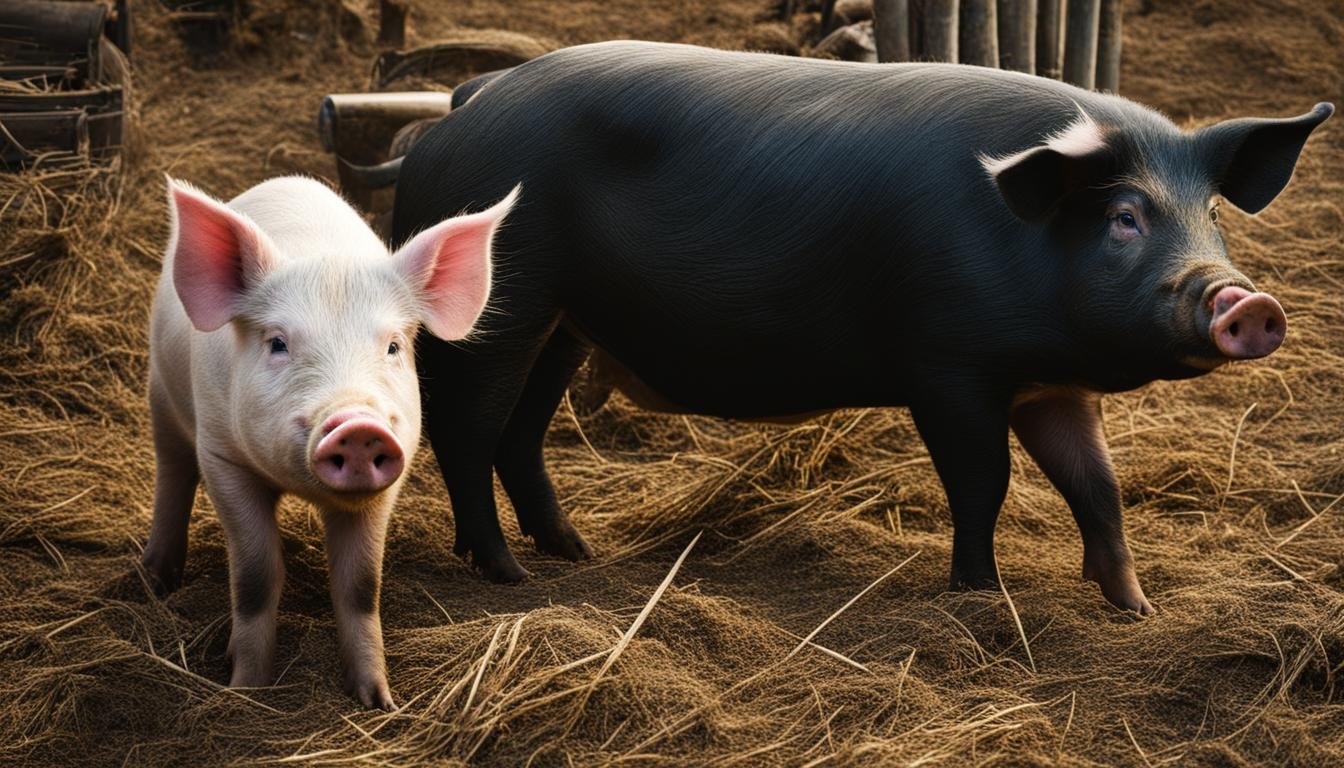How Long Do Pigs Live?
Pigs are fascinating creatures that have captured the attention of humans for centuries. From their unique grunts to their impressive intelligence, these animals never cease to amaze us.
But have you ever wondered about their lifespan? Do pigs live for many years or do they have a shorter lifespan?
In this article, we will explore the intriguing world of pig lifespan, from the factors that affect it to the aging process of these remarkable animals.
Key Takeaways
- Discover the average pig’s lifespan and what affects it.
- Understand the pig aging process and the changes that occur as pigs grow older.
- Explore the factors that influence pig lifespan, including genetics, diet, and living conditions.
- Learn about the concept of “pig years” and its relation to aging in pigs.
- Discover what practices and measures can promote longevity in pigs.
Understanding Pig Lifespan

The average pig’s lifespan varies depending on various factors. Some pigs live longer than others due to genetics, diet, and living conditions. Contrarily, some pigs have shorter lives due to underlying illnesses or mistreatment.
The longevity of pigs is also dependent on breed. For instance, some breeds have a shorter lifespan than others. According to ScienceDirect, most pigs live for about six years.
The average pig’s lifespan can vary depending on various factors such as genetics, diet, and living conditions. However, on average, pigs can live anywhere from 8 to 15 years in captivity.
The life expectancy of pigs can also be influenced by the environment in which they live. Pigs living in unfavorable conditions, such as those exposed to extreme temperatures or overcrowding, tend to have a shorter lifespan compared to those living in conducive environments.
A study by the University of Illinois Extension found that the life expectancy of pigs can be increased by providing appropriate nutrition, and veterinary care, and maintaining a clean living environment. Proper care and attention can help to ensure that pigs live longer, healthier, and happier lives.
Factors Influencing Pig Lifespan
The lifespan of pigs can be influenced by various factors, such as breeding practices, health care, environmental factors, and stress levels. Studies have shown that high stress levels can shorten the lifespan of pigs by increasing their vulnerability to illnesses and reducing their overall health.
Pigs that are bred using genetic modification techniques can also have shorter lifespans compared to their non-modified counterparts. This is because genetic modification has been known to interfere with the pig’s natural system, affecting their health and overall lifespan.
In addition, environmental factors such as temperature, humidity, and access to clean drinking water can significantly impact pig lifespan. The Pig Site found that providing a high-quality environment for pigs can increase their lifespan by up to 25%.
Factors Influencing Pig Lifespan
Several factors influence the lifespan of pigs, including the pig mortality rate and pig years. The mortality rate is the ratio of the number of pig deaths to the number of live pigs on a farm over a given period. The pig years concept is based on the idea that one pig year is equivalent to three human years.
| Factors That Influence Pig Lifespan | Impact on Pig Lifespan |
|---|---|
| Breeding Practices | Determine the genetics and health of the pigs, which affects their lifespan. |
| Healthcare | The environmental conditions in which pigs live, for example, temperature, ventilation, and space, can affect their lifespan. |
| Environment | The environmental conditions in which pigs live, for example, temperature, ventilation and space, can affect their lifespan. |
It is essential to understand the factors affecting pig mortality rates and pig years during pig farming. This knowledge can help farmers ensure optimal health, welfare, and productivity for their pigs.
In the next section, we will explore the aging process of pigs, providing a deeper insight into their lives.
How Long Do Pigs Live? The Aging Process of Pigs

Pigs, like all living beings, undergo a natural aging process as they navigate through different life stages. Their life cycle typically comprises of four stages, including the neonatal period, the juvenile phase, the mature period, and the final stage, which is characterized by old age. The aging process in pigs brings about both internal and external changes, which play a crucial role in shaping the pig’s longevity and quality of life.
Internally, the pig aging process is characterized by reduced metabolic rates, which often lead to reduced digestion and a decrease in the overall immune system function. This aspect makes elderly pigs more prone to common diseases and infections. Furthermore, as pigs age, they tend to accumulate oxidative stress; this can lead to an increase in the number of damaged cells and tissue, a process that can shorten their lifespan.
Externally, pigs undergo a gradual decrease in their cognitive and physical abilities as they grow older. For instance, elderly pigs may experience a decline in their eyesight, hearing, and other sensory abilities, making it harder for them to adapt to new environments. Similarly, as pigs become older, they lose muscle mass and mobility, which can limit their range of motion and lead to physical constraints. They may also develop wrinkled skin and experience changes in their hair coat, although these are generally less significant than the other changes.
Understanding the aging process of pigs is vital for farmers, veterinarians, researchers, and anyone involved in the care of these animals. By keeping a close eye on their physical and cognitive abilities as they age, caretakers can provide the necessary support, such as special diets or medical care, to improve their well-being and prolong their life.
The aging process in pigs is a natural part of their life cycle, characterized by internal and external changes that can affect their longevity and quality of life.
Promoting Longevity in Pigs
Promoting longevity in pigs involves a holistic approach aimed at ensuring they live long and healthy lives. Proper nutrition is key to ensuring a long pig lifespan; feeding them a well-balanced diet rich in nutrients is crucial. Pigs also need access to clean drinking water at all times to maintain their health.
Veterinary care is another essential component in promoting longevity in pigs. Regular veterinary check-ups and vaccinations can help prevent diseases and identify any issues before they become serious problems. Pigs also need access to clean, comfortable living spaces that are well-ventilated, which helps prevent respiratory issues and promotes overall well-being.
As pigs age, they may require different care than younger pigs. For example, older pigs may have trouble eating hard food, so their diet may need to be adapted to meet their changing nutritional needs. They may also require additional comfort measures, such as a warm space to sleep or a soft surface to lie on.
Understanding the pig’s aging process is crucial to providing them with the best possible care. Monitoring their behavior and physical changes can help identify any potential health issues early on, ensuring that they receive the treatment they need to stay healthy and active.
Overall, promoting longevity in pigs requires a combination of proper nutrition, veterinary care, and a clean living environment that meets their changing needs as they age. By providing pigs with the care they need to thrive, we can help ensure that they live long and happy lives.
Pig Lifespan: Understanding the Secrets Behind How Long Do Pigs Live

As we have explored in the previous sections, the lifespan of pigs is a complex and fascinating topic.
It is important to understand the factors that impact pig lifespan to provide them with the best care possible and promote their well-being. Breeding practices, healthcare, and their environment are critical factors in the longevity of pigs. By providing proper nutrition and veterinary care and ensuring a suitable living environment, we can help promote a longer lifespan for these animals.
Furthermore, understanding the pig aging process is crucial in promoting their well-being. Pigs change both internally and externally as they age. This includes changes in behavior, health, and physical appearance. By recognizing these changes and providing appropriate care, we can ensure that pigs live a long and healthy life.
In conclusion, the lifespan of pigs is a topic that requires further exploration. By understanding the factors that contribute to their longevity and providing them with the best possible care, we can help ensure that they live a happy and healthy life. Whether for agriculture or as pets, pigs are remarkable animals with a unique aging process and lifespan that we can all appreciate.







